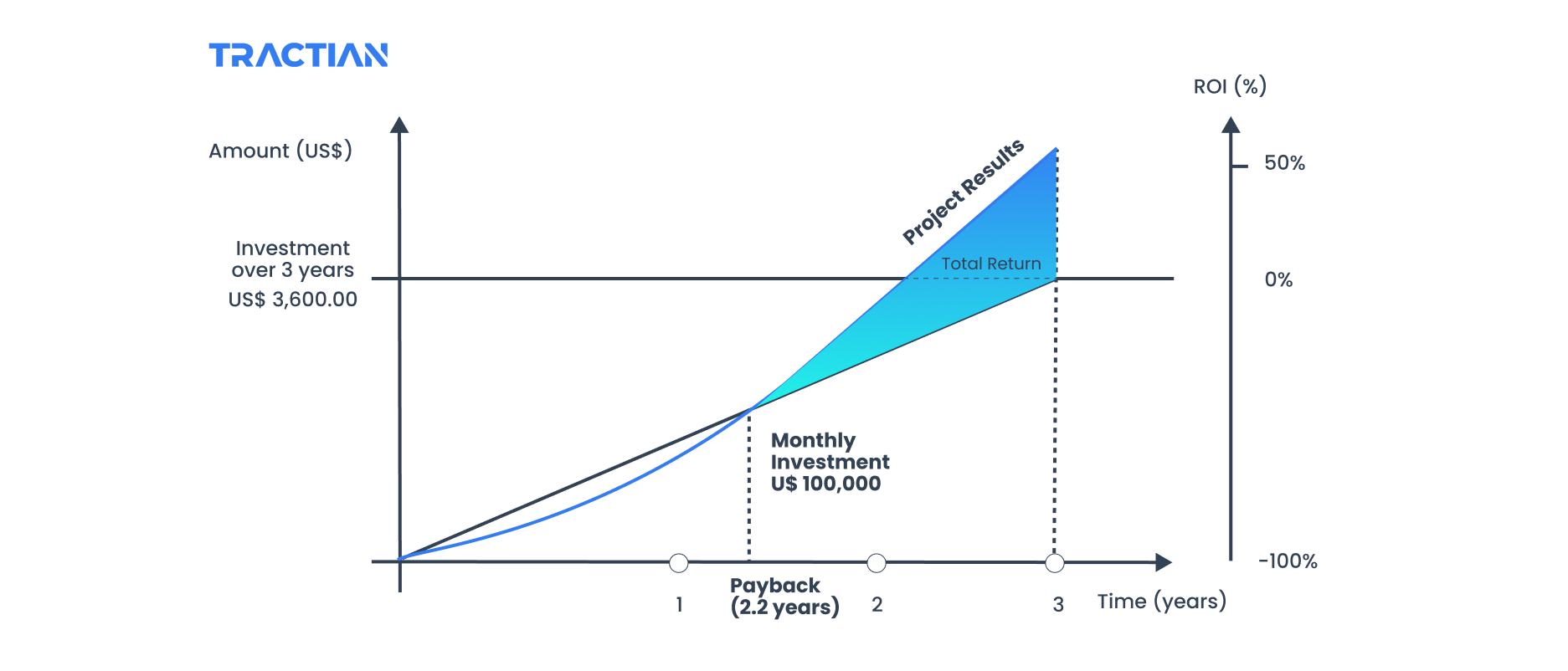ROI and Payback, growth, and productivity at any company are directly linked to where that company is investing and how those resources are being managed. In organizations such as factories or manufacturing facilities, where capital needs to be invested in labor, raw materials, equipment, and logistics, maintaining a healthy cash flow is crucial.
To achieve this goal, there are some Key Performance Indicators (KPIs) such as ROI and Payback, that give us a strategic view of profits and allow us to analyze which type of investment is bringing positive returns to the business.
8 Essential KPIs for Maintenance Management
ROI (Return on Investment) estimates the potential return of a business, product, or service. Payback, on the other hand, is related to the return time of an investment, that is, the time it will take for the profit to equal the invested amount.
But how do we calculate these indicators? First of all, we must understand the difference between them, so we will know when to apply each one to have a better view of future plans and achieve greater profits.
Want to learn how much your company is getting back from an investment? Use our ROI Calculators!
ROI vs Payback
What does ROI mean? And what is Payback? Don’t worry, we’ll cover them both in the next section, but essentially, they will help you determine if the investment made has paid off. Based on these KPIs, decision-making in various areas will be easier, clearer, and more reliable, since it is driven by data.
What Is ROI and How to Calculate It
As mentioned earlier, ROI is an estimate of the return on an investment made by a business. This calculation is done based on a specific period of time, taking into account the amount invested, which will allow for a forecast of whether it is worth investing in a particular product or service.
But how to calculate ROI? First, we must find the difference between the gross profit obtained from the project over a specific period of time, and the amount invested. Then, this result is divided by the initial cost of the investment. The final value is expressed as a percentage. The formula for calculating ROI is as follows:

ROI should always be analyzed from a time-based perspective, meaning it is necessary to choose a specific time period for which it will be calculated. Typically, this period corresponds to the time during which the project will yield some benefit.
For example, let’s use a particular tool that has a value of US$ 4,000.00 and a 3-year life cycle. In this case, it would be interesting to analyze the ROI at the end of this period and also at some intermediate points, perhaps after one or two years. See the following graph:

In the example above, the return obtained from the tool progressively increases over time. After one year, ROI is at -80%, after two years it is at -10%, and at the end of its life cycle, it is at 60%. This means that at the end of the project, for every dollar invested, there was a return of 1.60.
On the TRACTIAN website, you can find a calculator to make calculating ROI easier. Check it out here.
What Does Payback Mean and How to Calculate It
Often confused with ROI, the main goal of Payback is to calculate the time it will take for the company to obtain a return equal to the value that was invested.
In other words, it’s the amount of time needed for every dollar invested to generate a return of the same value. Starting from the Payback result, a company can know when the investment will start to generate profits.
The formula to calculate Payback is as follows:

Considering the same example we used before for ROI, here is a chart analysis of the moment where the company achieved Payback:

In this example, it took over 2 years for the project’s return to equal its cost, or for the tool to pay for itself. Something important to note is that the Payback point is also the same moment when ROI equals zero.
Any value obtained after the Payback point represents profit. To calculate the total profit, simply analyze the gains after the Payback point until the end of the project.

ROI and Payback in Subscription-based Projects
Now that you understand the definition of ROI and Payback, you might be wondering in which specific situations these KPIs can be used. Essentially, they are strong allies in planning any project you want to implement in your company.
They can be used for projects with monthly payments, such as services with subscription-based tools, which are becoming increasingly common in the industry as they allow for quicker project starts and lower risks for companies.
In these cases, the calculations may seem more complex, especially if the tools are applied in various different locations or assets, as they will depend on more complicated mathematical approximations. However, with some simplifying techniques, they can become equally manageable. The main technique is to calculate the ROI in short, predetermined time periods and analyze if there was already Payback at that point.
For example, let’s say our tool has a monthly cost of US$100. The total cost will increase each month, but it will start at much lower levels.

Analyzing this case at three different points in time, we can tell:
- After one year, ROI is at -10% and there has still been no Payback;
- After two years, ROI is at 20% and, consequently, there has already been Payback;
- After three years, ROI is at 60% and there has already been Payback.
In conclusion, even in subscription-based projects, where payment is done monthly, ROI and Payback are strong allies when it comes to deciding whether or not to make an investment.
Where to Apply Maintenance KPIs in the Industrial Sector?
Now that you know the differences between ROI and Payback, let’s analyze in which situations these performance indicators prove to be particularly useful for decision-making in business management, through projections and profit estimations in businesses.
Investing in Maintenance
ROI and Payback calculations are extremely useful when we think about maintenance activities, processes, and routines. Through these KPIs, plant managers and operational leaders can understand if gains in terms of productivity, reliability, and availability of machines are in line with the investments applied to each type of maintenance.
Let’s use the example of Amsted Maxion, considered to be a global leader in the foundry industry all across the world. In January 2021, the company invested in TRACTIAN’s online condition monitoring system to implement predictive maintenance processes on some of the plant’s critical equipment.
Before adopting the technology, unexpected failures and unplanned downtime were recurrent. After making this investment, the scenario changed completely: the auto diagnosis insights generated by the platform allowed maintenance teams to act before failures happened. As a result, the average repair costs decreased by almost $2,500 for each monitored machine and $50 for each hour of downtime.
With the reduction in reactive maintenance costs, the company was able to reach and prove ROI and low Payback time.
Implementing New Technologies
Using ROI and Payback is also crucial when evaluating improvement implementation within business processes. These calculations provide us with a clear view of the results of the investments made, allowing maintenance managers to determine if the strategies being employed are having an impact on the day-to-day operations.
In business environments, investing in new technologies and continuous improvement is a constant endeavor when it comes to increasing machine availability and reliability, as the health of these assets has a direct influence on a plant’s productivity.
One way to identify if the tools adopted by your company are effective in delivering the best possible performance is by applying ROI and Payback calculations to these investments.
Equipment Failure Prevention: A Guide for Senior Management
Using TRACTIAN’s condition monitoring sensors and CMMS/EAM combines data sampling, artificial intelligence, auto diagnosis, and mobile management to generate insights into the health of monitored machines and equipment, making predictive maintenance a strategic tool within a company’s maintenance plan.
Investing in this type of technology stimulates a positive return, as failure prediction prevents unplanned downtime that interferes with production lines and leads to unscheduled reactive maintenance expenses.
Want to know what return on investment and payback period could mean for your company with TRACTIAN’s solutions? Get in touch with one of our experts and get a demo.


